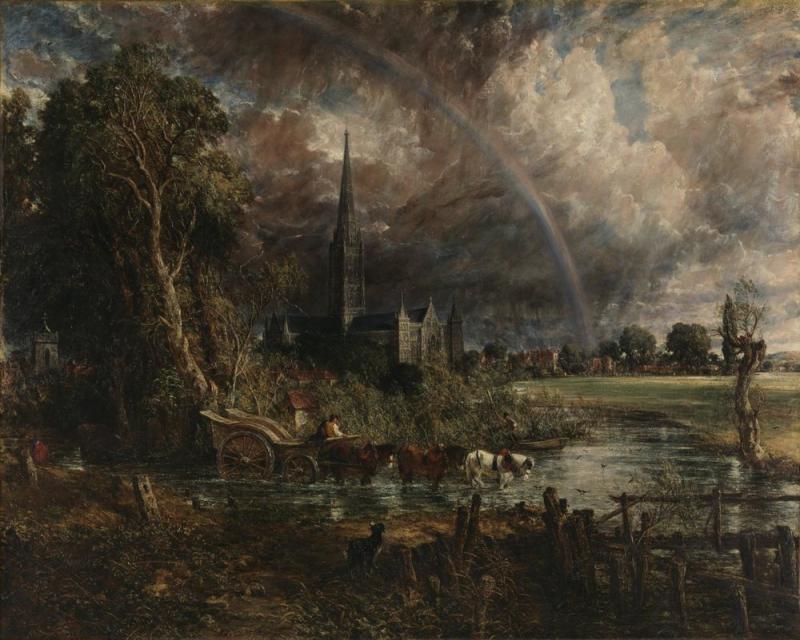The spat which lasted 187 years......Constable and Turner re-united
By: CINDY POLEMIS

The spat which lasted 187 years......Constable and Turner re-united
Is there really such a thing as artistic rivalry or is the notion more a product of our own obsession with comparisons and a curious need to have a 'favourite'? There are certainly some noteworthy artistic sparring partners: Picasso and Matisse; Reynolds and Gainsborough; Bacon and Freud; and of course Constable and Turner. In all cases, I am often asked: 'Who do I prefer?'. It is, of course, an impossible question to answer. In any case, I would never let on.
The Tate has given us an opportunity to revisit one of the most famous feuds between the two greats of 19th century British landscape painting, John Constable and JMW Turner. For the first time in 187 years, Constable's Salisbury Cathedral From The Meadows and Turner’s Caligula's Palace And Bridge will be reunited, hanging together in the relative peace of Tate Britain.

John Constable, Salisbury Cathedral in the Meadows,(exhibited 1831) ,Tate
.

JMW Turner, Caligula's Palace and Bridge, (exhibited 1831,)Tate
The spat between the two men dates back to 1831 when Turner accused Constable of giving him a rough deal. The 1831 exhibition saw Constable named as the Royal Academy’s “hang man”, which meant he was in charge of arranging the paintings for the Summer Exhibition. In other words, his choice of who went where would be crucial for showcasing new work.
He initially gave the Turner one of the best positions, in the centre of the end wall of the Great Room at Somerset House, then the home of the Royal Academy. He had placed his Salisbury Cathedral in the Meadows , along with two works by Turner: Caligula's Palace And Bridge and Vision of Medea to the other side. So far so good. Before the exhibition opened, however, he made the last-minute decision to swap, putting his own offering centre stage.
The change, which Turner was not aware of until after the exhibition opened, did not go down well with JMW. In his defence, Constable argued that he changed his mind for the good of both artists. Rather unfortunately the two men were the invited to the same dinner afterwards. Turner was furious and it’s said that it was this incident which led Turner to upstage, some might argue humiliate, Constable the following year. The two artists had paintings hanging side by side once again: Constable’s Opening of Waterloo Bridge which he had spent ten years working on, and Turner’s seascape scene, Helvoetsluys-The City of Utrecht Going to Sea . The former was rich with magnificent reds, gold and silver; the latter altogether more monochromatic-a subtle cloudscape at sea.

John Constable, The Opening of Waterloo Bridge,1832, Tate
.

JMW Turner, Helvoetsluys-The City of Utrecht Going to Sea, 1831, Tate
Just before the opening Turner came in several times, standing behind Constable who was putting finishing touches on his work. Turner looked from one painting to the other and finally slapped a daub of red paint, slightly bigger than a coin, on his grey sea and went away without saying a word. The flash of intense red, against the cool sea tones, caused a sensation. Constable came into the room just after Turner had left. 'He has been here', said Constable,'and fired a gun'. The scene was brilliantly portrayed in Mike Leigh's film, Mr Turner.
The 1831 paintings have been reframed and reunited at Tate Britain for the Fire and Water display in the Clore Gallery, which will include fascinating contemporary reviews that remarked on Turner’s poetic imagination and Constable’s naturalism.The Salisbury Cathedral painting had been on long loan to the National Gallery. It was put up for sale in 2013 but saved from export after a national appeal, major grants from the Art Fund and the Heritage Lottery Fund, and an unprecedented partnership between the Tate, the national museums and galleries of Wales and Scotland, and the local museums in Colchester, Ipswich and Salisbury.
Come and see them at Tate Britain. They will be side by side once again until July 2019, but please, do not ask me which one I prefer.



My favourite artist is J.M.W.Turner, and when I was in London I spent much time in the Tate Gallery where most of his paintings were hung, in particular my favourite painting of all time, The Fighting Temeraire . It is more than a painting, it tells a story. The great sailing ship Temeraire had fought in many battles, but its day was over because steamships were now sailing the seas, and here it is being towed into port for the last time by a steam tugboat, with the end of the day depicted by a blazing sunset echoing the end of a era and the end of the life of the ship. A poll of the British people was held wherein The Fighting Temeraire was determined to be their most favourite painting.
The Fighting Temeraire (J.M.W.Turner / Tate Gallery)
Now you're in my wheelhouse.
Will post a link to this article shortly.
First mate? Thanks A.Mac.
The end of an era.
And the end of another one when the computer was invented - an era I'd like to return to.